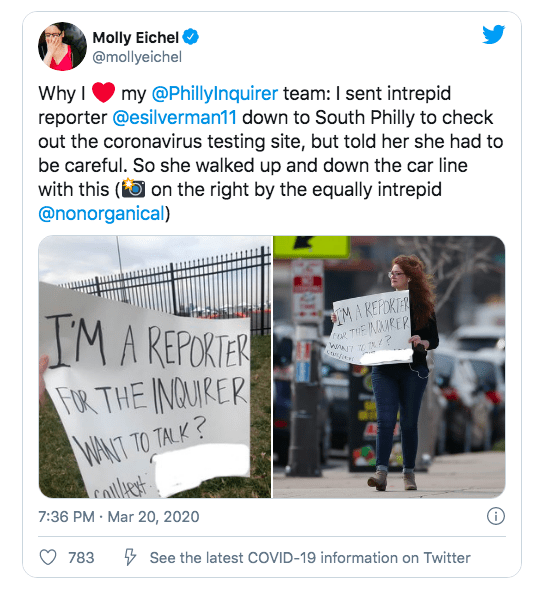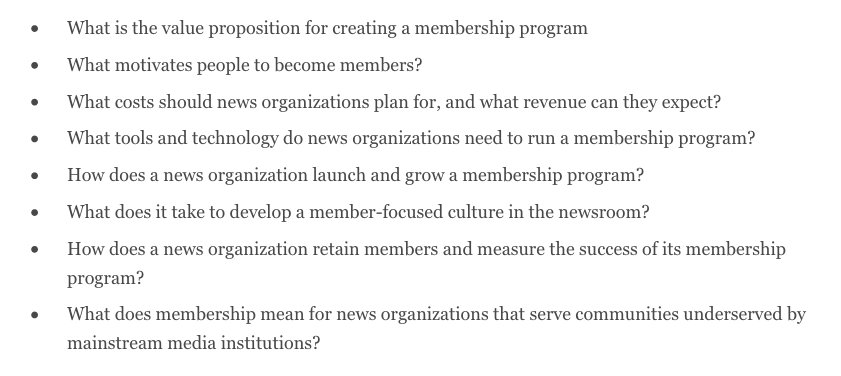Lenfest Institute: working with the Philly Inquirer as a ‘test kitchen’ for COVID innovation and more
(Lead image credit: Tim Tai, Philadelphia Inquirer)
The US’ Lenfest Institute only opened its doors in 2016 – and yet the name of its benefactor, Gerry Lenfest – no doubt echoes in his local Pennsylvania and beyond. A Wikipedia page about him (of course, it’s not a ‘paper of record’) skips quickly from some of his big achievements to the later years of his life, after he’d made and started to give away his fortune.
But the early years of this media tycoon’s life are perhaps worth remarking on even more – he experienced tragedy and then hardship, and then he took to sea. And it was only after he retrained as a lawyer that he had a chance meeting with another media tycoon, Walter Annerberg, that led to him taking a bet on cable – which paid off.
And the rest would be history, but it lives on in the huge variety of philanthropic work he did, not least, leaving more than $20 million to what is now the Lenfest Institute for Journalism, gifted alongside the ownership of what remains the for-profit Philadelphia Inquirer.
The Inquirer still prints seven days a week, and adds grants from the Lenfest Institute to its digital subscription offer and a newer donation ‘ask’, which all make it look like a well-rounded local paper fighting fit for its future.
Unique business structure
What may be unique about the Lenfest Institute’s relationship with the Inquirer is its business structure – a not-for-profit supporting a for-profit – versus those newsrooms that are now exclusively not-for-profit, or those publishers that are owned by a foundation, and are themselves not-for-profit.
Joseph Lichterman, the Lenfest Institute’s manager of editorial and digital strategy, knows his way around such journalism innovation. He currently produces a newsletter on the topic for the organisation, Solution Set, and previously worked at the Nieman Journalism Lab at Harvard University.
“We’ve talked in the past about the Inquirer as a ‘test kitchen’, a place to test new ideas and develop new models for local news,” Lichterman explains. “And then we can hopefully export them and share lessons with other local news organisations. So I think that’s definitely an asset of Lenfest and what makes it unique.”
“And so, for example, as COVID really took off they took down the paywall for much of the COVID coverage and created a landing page and the top of the landing page had both ‘subscribe’ and ‘donate’ links, so folks could support the Inquirer in a way that made sense for them.
In what is clearly Lenfest-style, these COVID innovations are all captured here in full for others to learn from – along with a donation drive, they launched a newsletter, did a roundtable for local people, and one reporter had a stroke of genius when attempting socially distanced news-gathering.

Socially distanced news-gathering
“But, we’re still a relatively young organisation and it’s a unique relationship because we’re the non-controlling owners,” he adds. “They have a separate business staff, separate leadership, answer to their own board. The newsroom is totally independent. And so it’s about figuring out the best ways to collaborate that works for everyone. And so it’s still very much a work in progress.”
Local Lab
What adds to its distinctiveness is the Lenfest Local Lab, which directly supports innovation at the newspaper, led by Sarah Schmalbach, but also sends its work out into the world so others can benefit from what they have learned.
“They’re a sort of a small product UX research team and the idea is to try and think about and identify ways to engage with local audiences in new and innovative ways,” Lichterman explains.
“I think one of the things local news organisations struggle with is they get so caught up in the day-to-day coverage, in the day-to-day product development cycle, that it’s difficult to take a step back and think about trying new things, running experiments, doing things for the sake of learning and knowledge and advancing the field.
“So the Lenfest Local Lab’s goal is to be able to do that type of research and do that type of innovation away from the day-to-day constraints of running the news organisation.”
The Lab team is able to work closely with the Philly Inquirer, with access to their newsroom and journalists. Lichterman says this means they’re often “trying to present the journalism in different ways and potentially make it more accessible or utilise different functionalities”.
Their latest experiment on doing local news at scale is the first of a number of hyperlocal newsletters, which is launching to cover a neighbourhood in Philadelphia called Fishtown, supported by the Google News Initiative.
“They’re trying to see if there are ways to cover neighbourhoods in more automated ways,” Lichterman explains. “As ‘metro newsrooms’ have shrunk, they’ve had to sort of ‘regionalise’ their coverage and are not able to provide as targeted, on-the-ground reporting.
“And so the idea with The Hook is to be able to combine original reporting with the Inquirer’s existing reporting, and public data sources, and compile it in a way that is valuable and interesting and user-friendly, and also potentially sustainable. So they’re also working with the Inquirer to sell ads in the newsletter, because if most of the readers are going to be in the neighbourhoods, if you’re a local business, that’s a good audience you want to reach.”
Collaborative, experimental, open
The UX lead on the project, Faye Teng, provides a really thorough and refreshingly transparent account of what you might want to do before trying the same thing.
Much of what the Lenfest Institute does is collaborative, much is experimental and much is open. The Lab also worked with the Brown Institute for Media Innovation to use artificial intelligence to map out the kinds of places that get covered in the news Philadelphia – and the kinds of stories that get written.
When they set out, they asked:

What can be learned from seeing a set of article locations on a map?
“And they’ve been able to use the underlying technology to create a COVID landing page,” Lichterman explains, “so if you want localised COVID coverage about your county, for example, you can go there and it’ll pull in automatically all the COVID stories that are written. So that means more localised coverage of schools or restaurant openings and things like that.”
Diversity, equity, inclusion
In a similar vein, the Lab has mapped restaurant reviews and public art, and also committed to make sure this is a tool that can be used in any newsroom.
“But it’s also thinking about diversity, equity and inclusion issues, in making sure that coverage is representative of communities,” Lichterman adds. “I do think journalists need to do a better job of amplifying voices and making sure that we’re representative of communities. It’s the right moral thing to do, but journalists sort of have this sense of duty to the public and we need to make sure we’re actually serving the public.
“And there’s a real business imperative, also, in that if you are going to become more dependent on reader revenues, for example, whether it’s through subscriptions or donations or membership, whatever it may be, people are going to want to see themselves in the coverage if they’re going to contribute to it and support the journalism. So I think that’s something worth keeping in mind as well.”
Lichterman is keen to talk ‘membership, donation, subscription, or not?’, as earlier this year the Lenfest Institute partnered withMembership Puzzle Project (MPP) to create the Google News Initiative-backed Membership Guide, MPP’s latest effort to try to help answer the industry’s questions on this increasingly dynamic revenue stream.
The team, headed by Jay Rosen of New York University, with the research directed by Elizabeth Hansen from the Tow Center for Digital Journalism at Columbia, and managed by Ariel Zirulnick, who’s also head of MPP’s Membership in News Fund, set out to ask, and where possible, answer:

What do we need to know before we do membership programmes?
The result is the hugely comprehensive Membership Guide, launched in September 2020, providing what Lichterman says the team considers “a tactical, practical guide for implementing membership programmes”.
After more than three years of ‘public research’ by the Membership Puzzle Project itself, the Guide brings together more than 30 case studies and interviews with 50 newsrooms.
Membership, donation, subscription
Lichterman explains that the project “looks at every step of your membership journey, from deciding if membership is right for you – because it isn’t necessarily for every organisation – to then launching and implementing a membership programme, and continuing to iterate and grow on it”.
Explaining some key takeaways from the Guide, he says: “membership is different from subscription, necessarily. If you’re a subscriber, you pay to get access. So there is a paywall and it’s really more transactional.
“With membership, you’re feeling like you’re joining a movement, you’re part of a cause. You’re giving not only your money, but potentially time and ideas, and other sort of things. You access it because it’s something to believe in and something that you think is beneficial to your community, or society more broadly.”
But he acknowledged there’s lots to be learned from older subscription models, and that there is much to be said for ‘doing a number of things to make money’.
“The Guardian is a really good example, you can sort of put multiple models together, so subscription and membership aren’t mutually exclusive. And you can incorporate ‘memberful routines’ and start to build toward developing that loyal audience and making people open to the idea of membership, and being engaged with the coverage before launching a specific membership programme. So you’re able to sort of do it in stages and meet your audience where they are.”
One publisher interviewed for the project, Lichterman explains, when considering whether people would be willing and able to pay online to join, realised they had a large part of their audience who wouldn’t or couldn’t. “They had to rethink their strategy to set it up for mailing and things like that… They have cheques, which is something you might need to think about. But, then, once you know you have an audience who’s going to pay online, you can set up recurring payments and optimise your checkout flow and do all these e-commerce strategies to really be able to do that well.”
Digital marketers with a good tech stack
He emphasised the need to ‘think like digital marketers’ and that, where a lot of newsrooms, legacy or led by a team of journalists in a startup, can fail to appreciate a good tech stack.
“They may think that it’s just part of a website and publish, but not only do you need a website, you need a CRM to be able to track your members and the way they’re interacting with you, and to be able to handle payments. You need an email service provider. You need to have APIs connecting all of those. And, if you’re going to do events, you need a platform being able to do events on and things like that. And so it gets more complicated and you want all those things to be able to talk together.”
He emphasised membership isn’t a silver bullet and pointed to very successful organisations like ProPublica, which actively seeks donations but does not have a membership program, instead it seeks reader input on particular investigations. Likewise, the New York Times is the New York Times, and its subscription model works just fine.
Something like Black Ballad, also in the Guide, launched a Slack community for Black women. “To do that intentionally is a great service to them and a great example of why representative media is so essential, you’re able to have conversations that you wouldn’t be able to have otherwise. And then, because Black Ballad has such a foothold in that community and is able to really identify that and be representative, then there’s a business opportunity there as well, whether it’s marketing or advertising or membership, which they’ve invested in.”
MPP, Lenfest, and Texas Tribune’s RevLab are also offering a free, Membership 101 training course for newsrooms through its Lenfest News Philanthropy Network, which feels like another opportunity to extend the legacy of this work.
Community listening
Through the Knight-Lenfest Local News Transformation Fund, a joint initiative with the Knight Foundation, it has also recently invested in the Philadelphia COVID-19 Community Information Fund supporting almost 20 news organisations to help get information to those that need it locally, and a Community Listening and Engagement Fund, around understanding real information needs.
The Lenfest Institute’s own website is unsurprisingly full of accessible tools and guides about doing journalism in times of COVID, from day-to-day reporting, to self-care for journalists.
“One of the good things that’s come out of the conversations recently around COVID, is thinking about what actual information communities need to meet their needs,” Lichterman acknowledges. “I’m in, for example, a very fortunate place that I have a job where I can work from home… So the information I need for my day-to-day life is probably very different from someone who is a frontline worker and still having to go into work every day at the supermarket or driving a bus.”
And the next thing that’s high up on the list at the Lenfest Institute is developing a standard learning and impact framework for the work they do. “Putting in hypotheses and making sure the data collection is there and seeing how the actual results align with the hypotheses,” Lichterman explains.
This feels like the final piece of the puzzle, to ensure a local legacy for Gerry Lenfest, by making sure his money is working to ensure the future of local news, in Philadelphia and beyond.
CONTACT

Joseph Lichterman, the Lenfest Institute’s manager of editorial and digital strategy
Twitter: @ylichterman @lenfestinst
